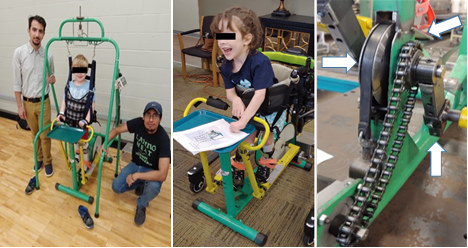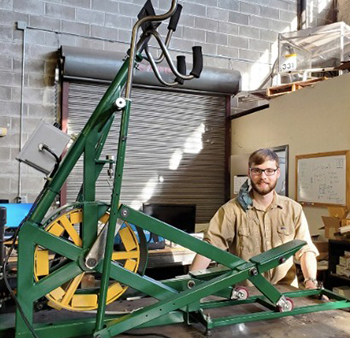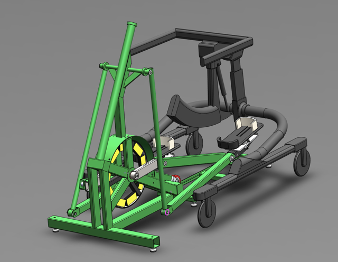By Hannah Weems
The UAB Department of Biomedical Engineering (BME) is known for routinely tackling daunting health problems head-on and has been doing so for more than forty years. In the community of people living with mobility impairments, affordability is one of the largest issues facing accessibility to therapeutic devices. It is no surprise, then, that UAB graduate students decided to directly combat this problem with the creation and development of a device called the “Motogaitor.”
This device is a motorized elliptical machine that was originally created and tested by Andres Guerrero in 2018 and has more recently been developed by graduate students in Biomedical Engineering, Ezz Abuhussein and John Easton, to treat a larger variety of patients on a budget and from home.
 Andres Guerrero, travelled to the United States after having completed his Bachelor of Science in Mechatronics Engineering at the Escuela Politecnica del Ejercito in Ecuador. In 2016, he enrolled in the University of Alabama at Birmingham’s Master of Design and Commercialization program.
Andres Guerrero, travelled to the United States after having completed his Bachelor of Science in Mechatronics Engineering at the Escuela Politecnica del Ejercito in Ecuador. In 2016, he enrolled in the University of Alabama at Birmingham’s Master of Design and Commercialization program.
“I was interested in using my engineering knowledge to help solve real world problems. When I heard about this program, I knew it was what I had been looking for,” says Guerrero.
It was at UAB that Guerrero was able to expand his design skills and expertise in the area of robotics. His goal was to develop products that would be used in the physical rehabilitation of children to improve mobility. Guerrero worked alongside Alan Eberhardt, Ph.D., Professor and Associate Chair of Education in the BME department at UAB. Dr. Eberhardt’s courses provided Guerrero with countless opportunities to find solutions to problems, but none were potentially as notable as the need of a local Children’s of Alabama patient, a 2-year-old child diagnosed with Level IV cerebral palsy. This illness increases spasticity in the limbs and impairs walking. The child’s mother reached out to Dr. Eberhardt in hopes of finding a device to help her child receive the rehabilitation he needed from home.
Guerrero observed the child’s condition, therapy and weekly routines before deciding to create an assistive device that could prevent the stress of constant travel to various therapy appointments. He worked in collaboration with Dr. Eberhardt and Steve Thompson, Director of the UAB Design and Fabrication Center, to develop the Motogaitor. Its design allows for a child to fit in the harness and stand on the pedals which gently move their muscles, on both upper and lower limbs, to help develop flexibility and strength.
 (left) User testing at Lakeshore (Ezz standing), (center) User testing at United Ability; (right) new additions to Motogaitor including freewheeling sprocket, adjustable resistance belt, and differential stride positioning
(left) User testing at Lakeshore (Ezz standing), (center) User testing at United Ability; (right) new additions to Motogaitor including freewheeling sprocket, adjustable resistance belt, and differential stride positioning
The team purchased a commercial elliptical device to provide the Motogaitor’s frame and elliptical function. An adjustable harness was created along with a portable frame structure which provided body weight support for the user to ambulate in place with the assistance of motorized pedals programmed to move continuously or in a prescribed stepping pattern. A stepper motor was joined to the main wheel using a chain-sprocket mechanism and the wheel was modified to allow for varying stride lengths. Velcro foot inserts were included on the pedals which would ensure its user remained attached to the elliptical and a holding tray was included to hold entertainment devices for the user. User testing of the Motogaitor was completed in 2018 at Lakeshore Foundation and United Ability in Birmingham, AL on nine children with differing mobility impairments, under parent and therapist supervision. Improvements were made to the device after testing, such as the implementation of a gait trainer to more easily position children over the elliptical.
 John Easton pictured with Motogaitor EliteIn 2020, John Easton, a BME graduate student and Experimental Biomechanics Core Lab Coordinator, decided to take the novel Motogaitor invention a step further for his master’s thesis in BME by broadening its use for post-stroke adult users. He began working on the second machine, dubbing the newly designed variation the “Motogaitor Elite.”
John Easton pictured with Motogaitor EliteIn 2020, John Easton, a BME graduate student and Experimental Biomechanics Core Lab Coordinator, decided to take the novel Motogaitor invention a step further for his master’s thesis in BME by broadening its use for post-stroke adult users. He began working on the second machine, dubbing the newly designed variation the “Motogaitor Elite.”
The Motogaitor Elite is a specialized elliptical designed for users with hemiplegia due to stroke. It features walker accessibility, adjustable unilateral and bilateral resistance and freewheeling motor assistance. A difference in mechanical advantage between the left and right legs was achieved by adjustment of the pin and slider along the crank arm which allowed for the user to pedal against resistance.
By design, the Motogaitor Elite is relatively low cost, in hopes of increasing the likelihood of owning a therapy device such as this one in the home. Easton says, “We need more affordable devices that address the needs of this population. They are lacking in the market at present.”
 3-D rendering of completed Motogaitor Elite“This equipment is significant because it will allow people with disabilities to exercise at home with the potential of improving their gait,” says project mentor Dr. Alan Eberhardt, “We are writing grant proposals to receive funding to do safety and efficacy testing in hopes that the devices can ultimately be commercialized.” The team has a provisional patent on the mechanisms that allow free-wheeling and differential stride length and hope to move forward with commercialization of this cost-efficient device.
3-D rendering of completed Motogaitor Elite“This equipment is significant because it will allow people with disabilities to exercise at home with the potential of improving their gait,” says project mentor Dr. Alan Eberhardt, “We are writing grant proposals to receive funding to do safety and efficacy testing in hopes that the devices can ultimately be commercialized.” The team has a provisional patent on the mechanisms that allow free-wheeling and differential stride length and hope to move forward with commercialization of this cost-efficient device.
The Motogaitor’s original creator, Andres Guerrero, went on to secure his dream position as a Rehabilitation Engineer at Blythedale Children’s Hospital in Valhalla, New York where he develops parts and specialized toys for pediatric therapy. Ezz Abuhussein is now pursuing a Ph.D. at the University of Memphis. The Motogaitor Elite’s creator, John Easton, will graduate from UAB with his Master of Science in Biomedical Engineering in April 2021. He hopes to pursue a job in engineering assistive technology. As for the Motogaitor Elite, the device will act as a prototype for future research which will explore the effect of differential resistance ellipticals on lower limb musculature of users with hemiparesis.